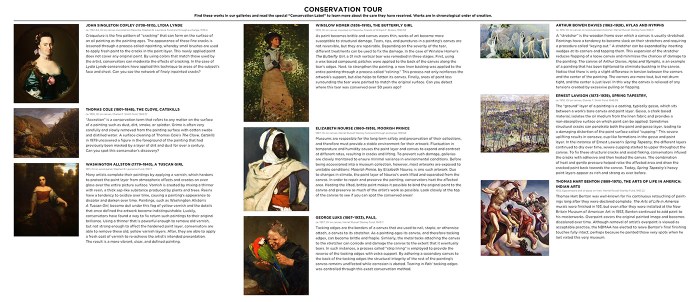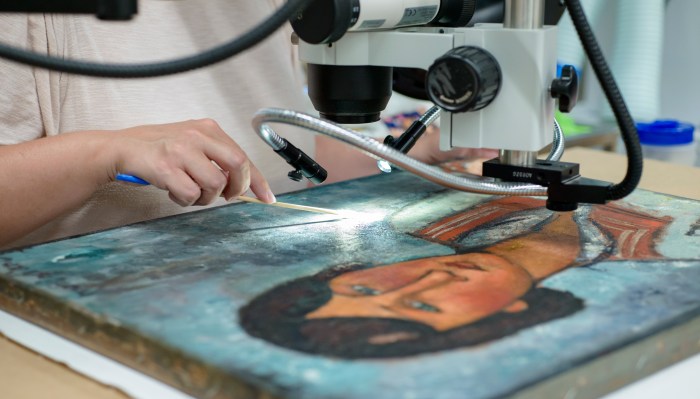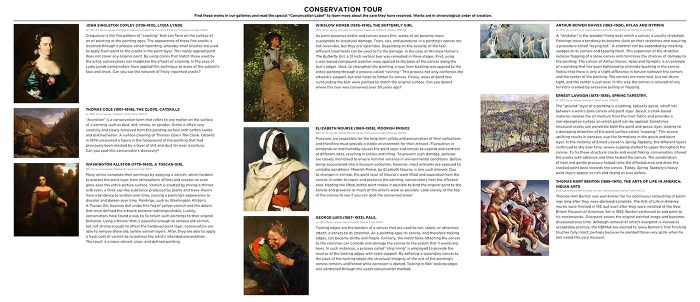
How to get into museum conservation? This journey into the fascinating world of preserving history begins with understanding the various pathways available. From apprenticeships and internships to formal education programs, we’ll explore the routes to becoming a museum conservator. This guide dives into the required qualifications, skills, and practical experience needed for success in this rewarding career field.
We’ll examine the diverse specializations, from paintings to textiles and ceramics, and the unique skills needed for each.
The path to becoming a museum conservator is multifaceted. It requires a strong foundation in technical skills, like material analysis and restoration techniques, alongside historical and scientific knowledge. We’ll look at the importance of practical experience, the process of securing internships, and the vital role of networking within the conservation community. This journey culminates in exploring the exciting career paths, job market trends, and the daily tasks of a conservator.
Entry Points & Qualifications
Embarking on a career in museum conservation requires a blend of passion, meticulous skills, and specialized knowledge. Different entry points exist, each offering unique advantages and challenges. Understanding these pathways and the associated qualifications is crucial for anyone considering this rewarding yet demanding field.
Diverse Entry Paths
Museum conservation offers various entry points, ranging from formal education to hands-on apprenticeships and internships. Each path presents a distinct learning curve and career trajectory.
- Apprenticeships: Provide invaluable practical experience under the guidance of experienced conservators. These programs often offer a structured learning environment, allowing trainees to gain practical skills and build a network within the conservation community. However, apprenticeships typically require prior knowledge and may not always lead to formal qualifications.
- Internships: Offer opportunities to gain experience in a museum conservation setting. Internships can be shorter-term than apprenticeships and may focus on specific conservation techniques or areas of expertise. These placements often complement formal education or serve as a stepping stone toward more advanced roles.
- Formal Education Programs: Provide a structured curriculum covering theoretical knowledge and practical skills. These programs can lead to qualifications, such as degrees and certifications, and often equip individuals with a broad understanding of the field. The duration and cost of formal programs vary considerably.
Educational Qualifications and Skill Sets
The required educational qualifications and skill sets vary depending on the specialization within museum conservation. A deep understanding of the materials and techniques used in conservation is essential.
- Painting Conservation: Requires a strong foundation in art history, materials science, and painting techniques. Specialists in this area need to be able to identify and document damage, employ appropriate cleaning and repair methods, and understand the historical context of the artwork.
- Textile Conservation: Involves knowledge of various textile materials, their deterioration processes, and the appropriate treatments. Specialists in this area need to understand the history and cultural significance of textiles and utilize specific techniques for cleaning, stabilizing, and repairing them.
- Ceramics Conservation: Requires understanding the chemical and physical properties of ceramics, the various methods of restoration, and the specific techniques for treating damage and deterioration. Specialists in this area need to be adept at identifying and assessing damage to ceramic objects.
Comparing Entry Paths, How to get into museum conservation
Each entry path into museum conservation has its own advantages and disadvantages. The choice depends on individual circumstances, goals, and resources.
Getting into museum conservation requires a solid foundation in art history and meticulous attention to detail. You’ll need to build a portfolio showcasing your skills, ideally with experience in a relevant field. This includes learning about the proper handling and preservation of artifacts, much like businesses are now needing to rethink their reliance on email in the face of a rising tide of spam, as discussed in this article about spam boom prompts call for businesses to ditch email.
Ultimately, dedicated study and practical experience are key to landing a position in this rewarding field.
| Entry Path | Time Commitment | Cost | Potential Career Progression |
|---|---|---|---|
| Apprenticeship | Variable, typically several years | Low to moderate (often no tuition fees) | Potential for advancement with experience and skill development |
| Internship | Variable, typically shorter-term | Low to moderate (sometimes with stipend) | Opportunity to gain experience and network, often a stepping stone to other opportunities |
| Formal Education | Variable, ranging from several months to several years | Moderate to high (tuition fees and living expenses) | Strong foundation for a career, access to a broader range of employment options |
Educational Requirements
Formal training is crucial for a career in museum conservation. Typical educational requirements include degrees in art history, conservation, or related fields, combined with specific certifications or professional qualifications.
“A Master’s degree in Conservation is highly desirable and often necessary for specialized positions.”
Essential Skills & Knowledge
Museum conservation is a multifaceted field requiring a blend of technical skills, historical knowledge, and critical thinking. It’s not just about preserving objects; it’s about understanding their history, material composition, and the best ways to protect them for future generations. Conservation professionals must be adept at identifying issues, employing appropriate techniques, and adapting to new challenges.The field demands a deep understanding of materials, from delicate textiles to robust ceramics.
Conservationists must be able to analyze these materials to determine their condition and the best methods for preservation. A crucial part of this process is employing the correct techniques to restore or stabilize objects without causing further damage.
Technical Skills
Conservation requires a wide range of technical skills. Material analysis is fundamental. Conservationists use various scientific tools to identify materials, assess deterioration, and determine the best treatment options. For example, X-ray fluorescence (XRF) can identify trace elements in pigments, helping determine the origin and composition of paints. Object handling is equally important.
Conservationists must handle objects with extreme care to avoid further damage. Specialized tools and techniques are crucial for safe handling. Restoration techniques are another critical skill. These range from cleaning and mending to stabilization and reconstruction, each demanding a high degree of precision and experience. Different materials require different approaches.
For instance, mending a torn fabric requires different techniques than stabilizing a fractured ceramic piece.
Historical and Scientific Knowledge
Understanding the history of an object is crucial for effective conservation. This includes its provenance, previous treatments, and intended use. This historical context provides critical insights into the object’s condition and helps guide the conservation process. A strong scientific understanding is also essential. This knowledge allows conservationists to comprehend the chemical and physical properties of materials and the effects of environmental factors on their deterioration.
For example, understanding the chemical composition of pigments helps conservationists choose the appropriate cleaning methods to remove dirt without damaging the pigment itself.
Critical Thinking and Problem-Solving
Effective conservation relies heavily on critical thinking and problem-solving skills. Conservationists face complex challenges, requiring them to analyze the problem, assess the object’s condition, and devise the most appropriate solution. This often involves considering various factors and evaluating different options before making decisions. For instance, when faced with a deteriorating painting, a conservationist must decide if cleaning is necessary, and if so, what method to employ.
They must consider the potential risks and benefits of each approach and choose the one most likely to preserve the artwork without causing further damage.
Materials and Techniques
Museum collections contain a wide array of materials, from organic materials like wood and textiles to inorganic materials like metals and ceramics. Each material presents unique conservation challenges. For example, wood requires different preservation methods than textiles. Conservation techniques are tailored to the specific material and its condition. The techniques used for conserving textiles might include treatments to remove pollutants and strengthen weakened fibers.
Techniques for stabilizing a fractured ceramic might include using a specialized adhesive to repair the fractures.
Conservation Techniques
| Technique | Description | Application |
|---|---|---|
| Cleaning | Removing dirt, pollutants, and other contaminants from an object. | Removing surface grime from paintings, sculptures, or textiles. |
| Repair | Mending damaged objects using appropriate materials and techniques. | Mending tears in textiles, repairing fractures in ceramics, or restoring broken sculptures. |
| Stabilization | Strengthening weakened or unstable objects to prevent further deterioration. | Using supports and reinforcements to prevent the collapse of a structure, or treating a deteriorating wooden frame. |
Practical Experience & Training

Stepping into the world of museum conservation requires more than just academic knowledge. Hands-on experience is crucial for developing the practical skills and nuanced understanding necessary to excel in this field. Learning to handle delicate artifacts, applying conservation treatments, and collaborating with professionals are vital elements in building expertise.Practical experience and training provide invaluable opportunities to refine skills, gain confidence, and build a strong professional network.
This practical application of theoretical knowledge allows aspiring conservators to apply their understanding to real-world scenarios, making them more adaptable and effective in their future roles. Internships and apprenticeships offer structured learning environments that provide essential mentorship and exposure to diverse conservation practices.
Avenues for Gaining Hands-On Experience
Gaining practical experience in museum conservation is a multifaceted process. Various avenues are available to aspiring conservators, each offering a unique learning opportunity. Volunteering, internships, and apprenticeships are particularly valuable in providing direct exposure to conservation work.
- Volunteering: Volunteering at museums or historical societies provides entry-level experience in handling collections, assisting with research, and participating in basic conservation tasks. This often involves assisting with tasks like cataloging, cleaning, and basic preventative conservation measures, providing a foundational understanding of museum environments and handling techniques.
- Internships: Internships offer a more structured and in-depth experience, providing a chance to work alongside experienced conservators on real conservation projects. They often involve specific tasks and responsibilities, allowing for focused learning and development. Internships provide invaluable experience in a professional environment and often lead to long-term employment opportunities.
- Apprenticeships: Apprenticeships are intensive training programs that provide comprehensive instruction in museum conservation techniques. They often involve a combination of theoretical instruction and practical application, with ongoing mentorship and guidance from experienced conservators. Apprenticeships offer a more structured learning path, focusing on practical skills and expertise.
Seeking and Securing Relevant Internships or Apprenticeships
Securing a relevant internship or apprenticeship is a strategic process requiring careful planning and preparation. Researching potential opportunities, tailoring your application materials, and networking within the conservation community are essential steps.
- Research: Thoroughly research museums, historical societies, or conservation organizations offering internships or apprenticeships. Identify programs that align with your interests and goals, paying attention to the specific conservation specializations offered.
- Application Materials: Prepare a compelling resume and cover letter highlighting your relevant skills and experiences. Include details about any prior volunteer work, academic projects, and related coursework. Demonstrate a genuine interest in the field and specific conservation projects.
- Networking: Attend conferences, workshops, and networking events to connect with professionals in the field. Building relationships with conservators can open doors to internship or apprenticeship opportunities and provide valuable mentorship.
Building a Conservation Portfolio
A strong portfolio is essential for showcasing your skills and experience to potential employers. It demonstrates your practical knowledge and your ability to apply conservation principles in a professional context.
- Documentation: Document your experiences through photographs, written reports, and detailed records. Include information about the artifacts you worked with, the techniques you used, and the outcomes of your interventions.
- Examples: Include examples of your work, such as photographs of projects, conservation reports, and sketches of your work. Highlight your contributions and demonstrate your ability to apply conservation principles.
- Presentation: Present your portfolio in a clear and organized manner, showcasing your skills and experiences effectively. Use a professional format and ensure your work is well-presented and easily understood.
Career Paths & Opportunities: How To Get Into Museum Conservation

Museum conservation offers a diverse range of career paths, from hands-on restoration to research and management. It’s a field demanding meticulous attention to detail, a deep understanding of history and materials science, and a passion for preserving cultural heritage. This exploration delves into the various career options, current trends, and future prospects within this rewarding profession.The museum conservation field encompasses a range of roles, each with its unique responsibilities and requirements.
The journey from an entry-level position to senior roles often involves a combination of academic study, practical experience, and professional development. Navigating the field requires careful consideration of personal interests and career goals.
Getting into museum conservation takes dedication and a blend of skills. You’ll need a strong background in the sciences, ideally with a degree in something like archaeology or art history, plus experience working with historical artifacts. While Google’s recent decision to shelve the Nexus Q project ( google puts its nexus q dream on hold ) highlights the unpredictable nature of tech development, it’s important to remember that perseverance and a passion for preserving history are key to a successful career in this field.
A solid understanding of materials science and meticulous attention to detail are also essential to thrive in this field.
Career Paths Within Museum Conservation
Museum conservation encompasses several interconnected roles, each crucial for the effective preservation and interpretation of cultural artifacts. These positions often overlap, and individuals may transition between them throughout their careers.
- Conservators are the core of the field, directly responsible for the physical preservation of artifacts. They employ a wide range of techniques to clean, stabilize, and repair damaged items. This involves understanding the materials, their deterioration processes, and appropriate treatment methods.
- Curators play a pivotal role in museum management. They oversee collections, develop exhibitions, and interpret artifacts for the public. Their understanding of the historical context and cultural significance of objects is crucial for effective presentation and preservation strategies.
- Researchers play a vital role in advancing the knowledge base of museum conservation. They investigate new techniques, materials, and conservation challenges, contributing to the overall improvement of preservation practices.
Current Job Market Trends
The demand for qualified museum conservators is steadily increasing, driven by the growing awareness of the importance of cultural heritage preservation. However, competition for these positions is often fierce. The market is not uniform across different geographical areas or museum types. Major museums often attract top talent, creating a more competitive landscape.
- Specialization is becoming increasingly important. Museums are seeking conservators with expertise in specific materials or techniques, such as paper conservation or textile restoration. This reflects a need for refined skillsets and focused knowledge.
- Museums are emphasizing community engagement. Conservators are now expected to contribute to outreach programs, public lectures, and workshops, promoting a greater understanding of their work to the public.
- Interdisciplinary collaborations are gaining momentum. Conservators are increasingly working alongside scientists, historians, and other specialists to develop comprehensive approaches to preservation.
Future Prospects
The future of museum conservation is promising, with ongoing advancements in materials science and preservation techniques. The growing global interest in cultural heritage preservation suggests a continued need for skilled conservators.
- Technological advancements will continue to influence the field. Digital imaging, 3D modeling, and other technologies will enhance documentation, analysis, and restoration processes.
- A focus on sustainable practices is expected to emerge. Conservation strategies will increasingly prioritize environmental considerations and the long-term viability of preservation methods.
- The role of conservators in digital preservation is also likely to increase. With the growing volume of digital archives, conservators will play a crucial role in ensuring the long-term accessibility and preservation of digital content.
Typical Responsibilities and Daily Tasks of a Museum Conservator
Conservators engage in a wide range of activities, encompassing research, treatment, and documentation. A typical day might involve evaluating artifacts for damage, applying appropriate conservation techniques, documenting the process, and maintaining records.
Getting into museum conservation requires a blend of passion and practical skills. A strong foundation in art history or a related field is often a good starting point. Learning about the different types of materials used in museum artifacts, and their preservation techniques, is also key. Plus, a deep understanding of the latest technology in preservation, like the new tablets being used in museums – like those discussed in the article on google makes its play in tablets – can really give you an edge.
Ultimately, internships and networking within the museum community are crucial steps toward a successful career in this fascinating field.
- Assessment and Diagnosis: Conservators meticulously examine artifacts for signs of damage, deterioration, and potential risks. This involves identifying the materials, understanding their history, and assessing the level of deterioration.
- Treatment and Repair: Depending on the nature of the damage, conservators implement appropriate treatment methods, employing various techniques like cleaning, stabilization, and repair. This often requires precise handling and meticulous attention to detail.
- Documentation and Reporting: Every step of the conservation process is documented, including detailed records of the artifact’s condition, treatment methods, and materials used. This documentation is critical for future reference and understanding.
Researching Potential Employment Opportunities
Identifying potential employers is crucial for advancing a career in museum conservation. Exploring relevant websites, attending conferences, and networking with professionals are key strategies.
- Online Job Boards: Specialized job boards often focus on cultural heritage positions, providing a targeted approach to finding relevant opportunities.
- Museum Websites: Museum websites are valuable resources, offering information on current openings and career opportunities.
- Professional Organizations: Joining professional organizations dedicated to museum conservation can provide access to job postings and networking opportunities.
Potential Employers and Requirements
A range of institutions, including museums, historical societies, and private collectors, employ museum conservators. Requirements often vary based on the specific institution and position.
| Potential Employer | Specific Requirements |
|---|---|
| Major Museums (e.g., Metropolitan Museum of Art) | Advanced degrees, extensive experience, and specialization in specific materials or techniques. |
| University Art Museums | Strong academic background, research experience, and potential for teaching or research. |
| Historical Societies | Expertise in specific historical periods, materials, and preservation methods. |
| Private Collectors | Specialized skills and experience in handling and preserving valuable artifacts. |
Research & Development in Conservation
Pushing the boundaries of museum conservation relies heavily on ongoing research and development. Innovation in materials science and conservation techniques is crucial for addressing the ever-evolving challenges faced by cultural heritage institutions. This dynamic field is constantly evolving, driven by the need to protect and preserve irreplaceable artifacts for future generations.
The Importance of Research and Development
Advancements in conservation practices are directly linked to the development and application of new techniques. This continuous cycle of research and development allows conservators to tackle complex deterioration issues, often involving unique materials and environmental conditions. The understanding of deterioration mechanisms, combined with the development of effective interventions, ensures the long-term preservation of cultural heritage.
Latest Advancements in Materials Science and Conservation Techniques
Recent breakthroughs in materials science have provided conservators with powerful new tools and insights. Non-invasive analytical techniques, such as advanced imaging technologies, allow for a deeper understanding of material composition and degradation processes without causing further damage to the artifact. This allows for more informed conservation decisions, leading to better preservation outcomes.
Emerging Challenges and Opportunities in Museum Conservation
Museums face a multitude of challenges in the 21st century, including climate change, increased threats of vandalism, and the need for sustainable practices. Emerging challenges necessitate innovative solutions and proactive research to mitigate these risks. The development of environmentally friendly conservation methods and the creation of resilient storage and display systems are critical in addressing these contemporary concerns.
Specific Areas of Research Gaining Traction
Several areas of research are currently gaining significant traction within the field of museum conservation. These include the development of new, environmentally friendly materials and treatments, the improvement of non-invasive analytical techniques for material identification, and the study of deterioration mechanisms in diverse cultural heritage materials. The understanding of the interaction between environmental factors and artifact degradation is also a key area of focus.
Examples of Cutting-Edge Conservation Techniques
Numerous cutting-edge conservation techniques are being implemented to address specific deterioration issues. One example is the use of advanced imaging technologies to detect and document damage in artworks, allowing for preventative measures to be taken. Furthermore, the development of targeted treatments for specific material types, such as using bio-based polymers to stabilize wood or using advanced coatings to protect against environmental factors, is also contributing to advancements.
A significant advancement is the use of 3D printing to create replicas of damaged objects, enabling researchers to study the original artifact’s structure and history without risk of further damage.
Professional Organizations & Resources
Finding your footing in the demanding field of museum conservation requires more than just knowledge and skill. A strong network and access to resources are crucial for navigating the complexities of the profession. Professional organizations provide mentorship, networking opportunities, and vital resources that can propel your career forward.Professional organizations are vital for museum conservators, offering a wealth of support, from networking and career advancement to continuing education and advocacy.
These groups foster a sense of community among practitioners, promoting collaboration and knowledge sharing. They also play a critical role in shaping professional standards and ethical guidelines within the field.
Professional Organizations
Professional organizations provide a crucial support system for museum conservators. They offer a platform for sharing knowledge, collaborating on projects, and gaining recognition within the field. Membership often includes access to publications, workshops, and networking events, fostering professional growth and development.
- The American Institute for Conservation (AIC): The AIC is a leading international organization for museum professionals, including conservators. Membership provides access to a wide range of resources, including the AIC’s quarterly journal, Conservation News, which features articles on current conservation practices, research, and case studies. The AIC also hosts conferences and workshops, offering opportunities to learn from leading experts and connect with colleagues.
- The Institute of Conservation (ICON): ICON, based in the UK, is another prominent organization for conservation professionals. Members gain access to their publications, workshops, and events. ICON’s focus on international conservation efforts makes it a valuable resource for those interested in global conservation practices.
- The Association for Preservation Technology International (APTI): APTI serves a broader range of preservation professionals, encompassing museum conservation, archival science, and library preservation. This organization can be beneficial for those interested in a wider scope of preservation practices beyond museum contexts.
Continuing Education and Professional Development
Continuing education is paramount for museum conservators. The field is constantly evolving with new techniques, materials, and research. Regular professional development ensures that practitioners remain current with the latest advancements in conservation methods and technologies.
- Workshops and Conferences: Many professional organizations and institutions host workshops and conferences focusing on various aspects of museum conservation. These events often feature lectures from leading experts, hands-on training sessions, and opportunities to network with other professionals. Attending such events is a great way to stay informed and develop new skills.
- Online Courses and Resources: Online platforms offer a wealth of educational resources for aspiring and practicing conservators. These can range from introductory courses to specialized training on specific conservation techniques. They provide flexibility and accessibility for professional development.
Online Resources and Publications
Online resources are invaluable for those seeking information on museum conservation. Websites, blogs, and online journals provide access to a wealth of knowledge, ranging from introductory information to advanced research.
- Journals: Publications like the Journal of the American Institute for Conservation and other specialized journals are essential resources for staying abreast of the latest research and developments in the field. These publications feature articles from leading experts, allowing readers to learn about cutting-edge conservation methods and current issues.
- Websites: Many organizations and institutions maintain websites that provide detailed information on museum conservation. These sites often feature resources such as FAQs, guidelines, and news updates, making it easy to access essential information.
- Online Databases: Online databases can provide access to a vast collection of information on conservation materials, techniques, and case studies. These resources can be invaluable for conducting research and staying informed.
Recommended Resources
These resources provide further study opportunities for aspiring conservators. Exploring these books and articles can significantly enhance your understanding of the field.
- The Conservation of Museum Objects by various authors: This comprehensive resource provides a broad overview of museum conservation, including techniques, materials, and case studies. It is a valuable starting point for anyone new to the field.
- Articles from the AIC’s Conservation News: This journal provides practical and in-depth coverage of conservation issues, research, and case studies, keeping readers informed about current trends and advancements in the field.
Last Word
In conclusion, entering the field of museum conservation is a rewarding but challenging path. This comprehensive guide provides a roadmap, outlining the necessary steps to embark on this exciting career. From the entry points and qualifications to the essential skills and practical experience, we’ve covered the key aspects. We’ve also explored the diverse career paths, research and development in the field, and the crucial role of professional organizations.
Ultimately, this guide empowers aspiring conservators with the knowledge and tools to navigate this rewarding career journey.




